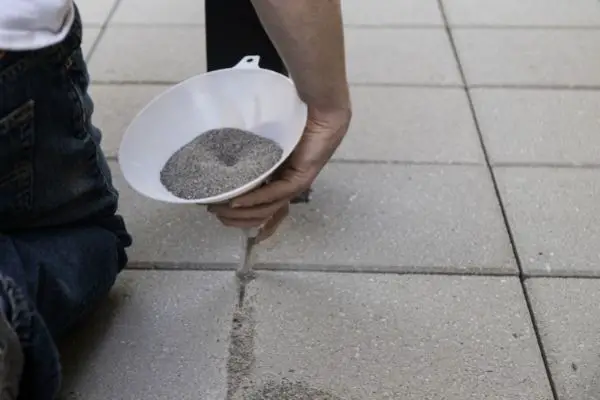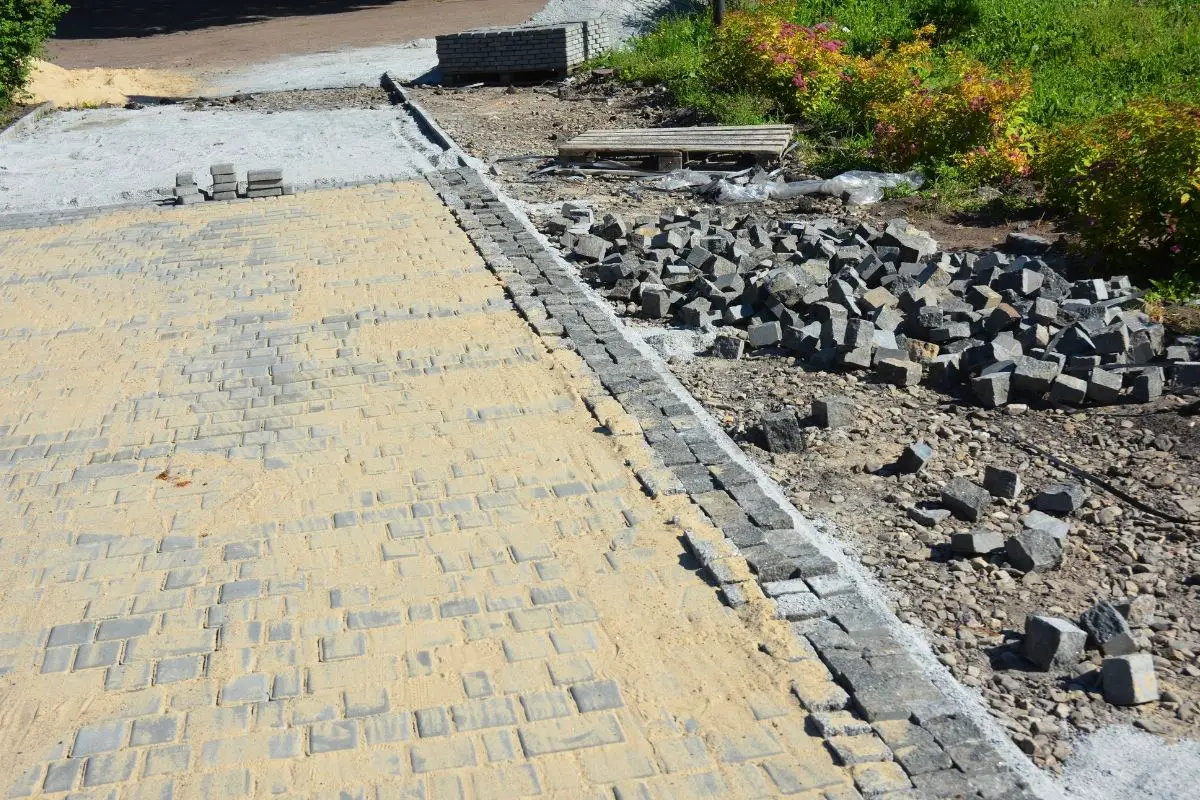Polymeric Sand vs Regular Sand for Pavers — Which is Better for Your Paving Project?
Homeownership means constantly finding projects to work on. And if you are a DIY-enthusiast like me, the list of projects is endless!
If installing a new patio or walkway is on your summer to-do list, there’s a good chance you’ll be working with pavers in the near future.
But placing stone or cement pavers in the desired location is just the first step. If you want your new hardscaping to last, you also need to fill the gaps between each paver with jointing sand.
Polymeric sand and regular sand both work great for filling paver joints. However, one might be better than the other for your specific project.

Ready to find out which special sand for pavers is best for finishing your patio or garden path? Here’s everything you need to know.
What is Polymeric Sand?
Unlike most sand used in construction and landscaping projects, polymeric sand is not a natural product. Instead, it is a manmade compound.
Polymeric sand is created by mixing fine sand particles with additives like silica. The purpose of these additives is to form a permanent bond between the sand particles.
Non-activated polymeric sand has the same texture as regular sand. Once water is added, the polymeric sand’s bonding agent activates to form a hard, gel-like compound.
What is Regular Sand?
Polymeric sand is not used in all hardscaping projects. It may not even be the most popular option.
All-purpose sand is the go-to product for sealing paver joints. This sand is also known as joint sand or leveling sand.
Regular paver sand may not include fancy bonding agents. But it does feature coarse sand particles that interlock to form a tough, long-lasting gap filler.
Polymeric Sand vs Regular Sand for Pavers: Is One Better?

Choosing the best sand for pavers often comes down to personal preference. Yet there’s no denying the potential pros and cons of using polymeric sand over regular paver sand (or vice-versa).
Here are the most important factors to consider when selecting which type of sand to use for your own landscaping projects:
Durability
Hardscaping is hard work, and you want that work to last for as long as possible. So the durability of your chosen paver joint sand is extremely important.
Polymeric sand can last up to 10 years when applied properly. Life expectancy will vary between specific products and in different climates.
Regular paver sand typically needs to be touched up every two years. This doesn’t mean that all of the sand will wash away within that time frame. But it does mean that regular maintenance is needed to keep your pavers from shifting.
Appearance
Once polymeric sand or paver sand are applied and set (in the case of polymeric sand), it’s hard to tell the difference without a closer look. Just like all-purpose sand, polymeric sand comes in a wide range of colors.
In terms of the day-to-day appearance of your pavers, polymeric sand may offer a cleaner look than regular sand. This is because the binding agents keep the sand particles in place while regular paver sand can easily be kicked or blown out of the joints.
Weed/Insect Control
Polymeric sand’s ability to stop insects and weeds from pushing through paver joints is a huge advantage. Polymeric sand will only become vulnerable to these weed seeds and burrowing insects like ants if cracks are allowed to form in the joints.
All-purpose sand will slow down weed growth and insect burrowing for a short time after installation. However, it’s not a long-term solution.
Ease of Application

The differences in applying polymeric sand vs paver sand are fairly insignificant. But the polymeric sand application process does include more room for error.
Both products can be brushed into the joints with a push broom. If you’re using polymeric sand, you must also activate the bonding agents with water.
Blowing away extra dust is often necessary to prevent a haze from forming on your pavers. This haze is caused by a thin layer of polymeric sand setting over the pavers’ surface and is nearly impossible to remove once set.
Price
Pound for pound, polymeric sand will almost always cost more than all-purpose sand. Keep in mind, though, that much of this extra cost is offset by polymeric sand’s greater durability and life expectancy.
Common Issues
One of the most common paver locking sand problems is haze. The best way to avoid this issue is to select a cement-free polymeric sand formula and ensure all excess dust is removed from your pavers before adding water.
Regular paver sand is prone to erosion, typically caused by harsh wind or rain. While this issue is annoying, it can be easily fixed by adding more sand or applying a sealant over the top of your pavers.
Frequently Asked Questions
Is polymeric sand permeable?
Polymeric sand is considered semi-permeable. The actual amount of water capable of passing through this compound varies. Some formulas may be more permeable than others.
By its nature, polymeric sand is less permeable than regular sand. But this lack of permeability is what gives polymeric sand its durability, weed resistance, and longevity.
What is paver sealant?
Paver sealant is a product applied to both the pavers and the joints in-between. It’s often used in conjunction with polymeric sand.
Paver sealant protects your pavers from stains and color fading. It can also strengthen the joints of your walkway, patio, or pool deck even further than polymeric sand alone.
Can you use polymeric sand for travertine pavers?
Yes, but it may not be the best solution. Travertine pavers tend to be laid with very small joint gaps. While regular sand can be swept into these gaps, the space is not large enough for polymeric sand to form a strong bond.
What is the difference between paver sand vs regular sand?
Paver sand is a colloquial term that can apply to either polymeric sand or all-purpose sand. Typically, though, it’s used to refer to the latter.






